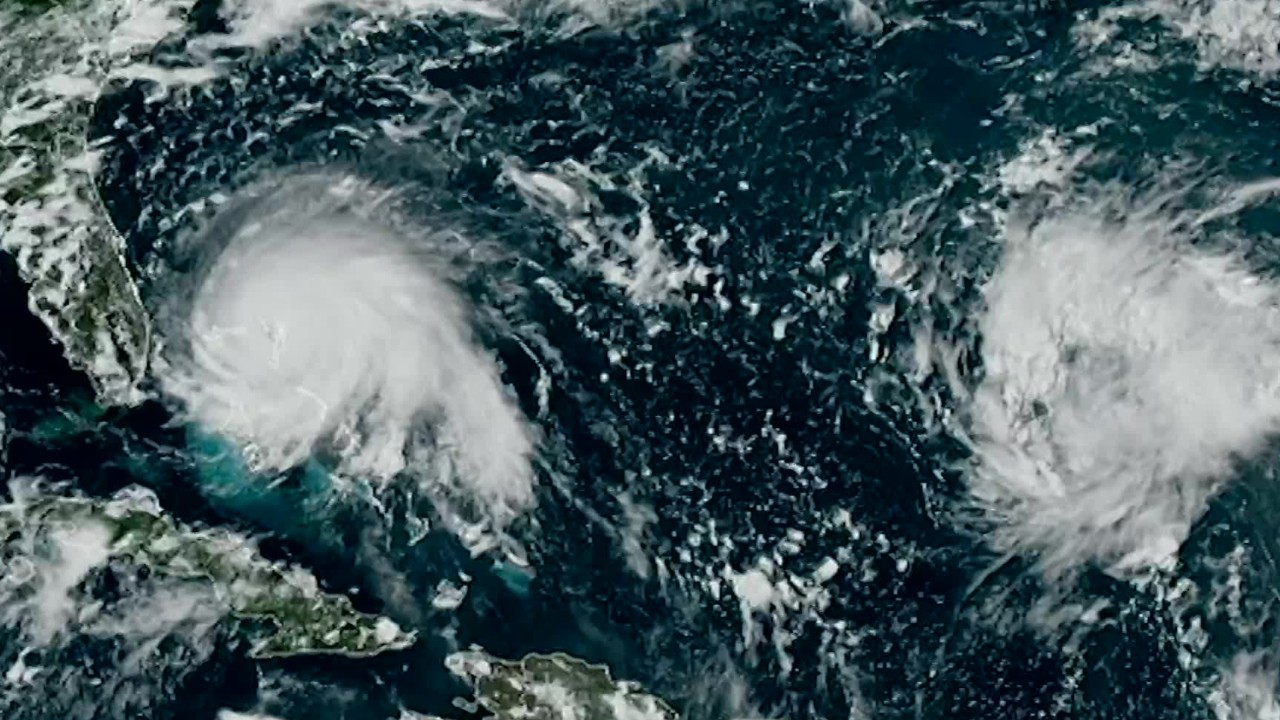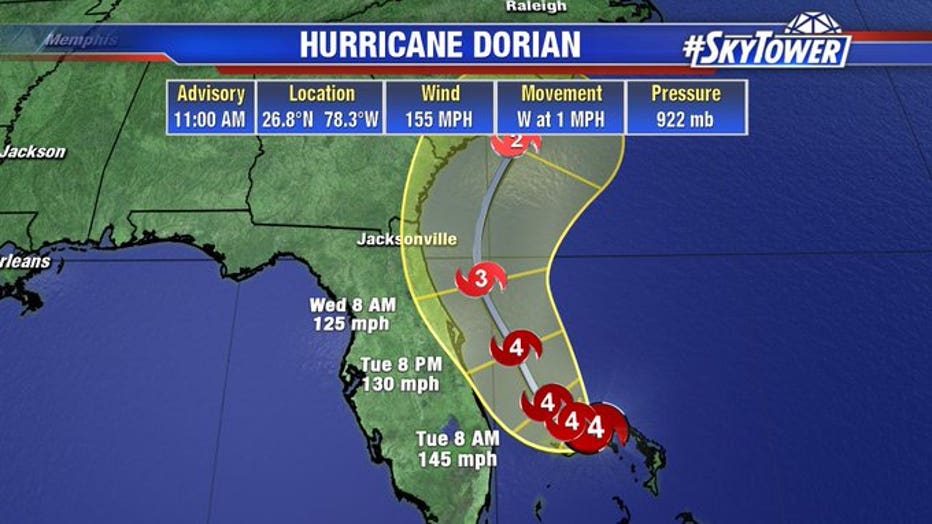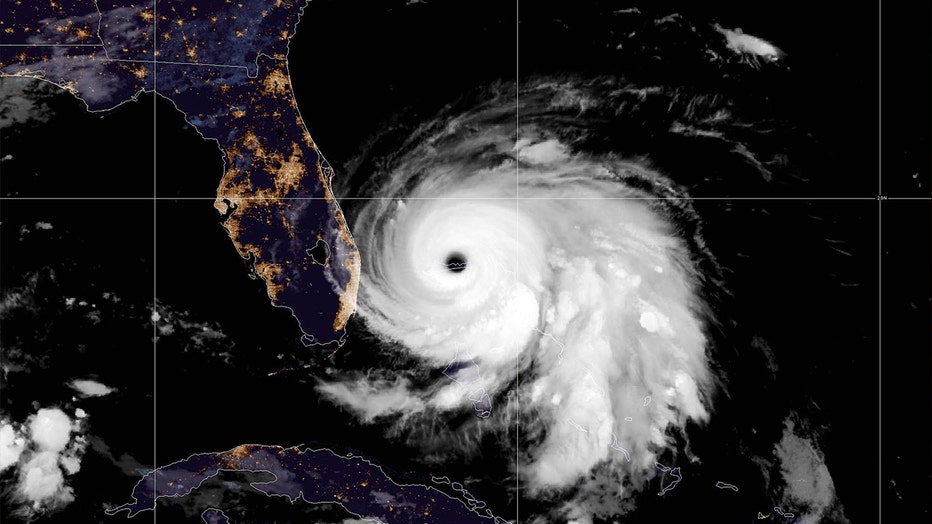Hurricane Dorian: Slow-moving Category 4 storm pounds Bahamas and kills 5, inches closer to US coast

Record-setting Hurricane Dorian inches closer to US coast
On Tuesday and Wednesday, Dorian is forecast to be 40 to 50 miles off Florida, with hurricane-force wind speeds extending about 35 miles to the west.
McLEAN'S TOWN CAY, Bahamas - In a slow, relentless advance, a catastrophic Hurricane Dorian kept pounding at the northern Bahamas early Monday, as one of the strongest Atlantic storms ever recorded left wrecked homes, shredded roofs, tumbled cars and toppled power poles in its wake.
Prime Minister Huber Minnis said at least five people were killed.
"We are in the midst of a historic tragedy," he said, calling the devastation "unprecedented and extensive."
The storm's winds decreased slightly to 155 mph as its westward movement slowed, downgraded Monday to a powerful Category 4 storm. It crawled along Grand Bahama island at 1 mph in what forecasters predicted would be a daylong assault.
By 11 p.m. EST, Hurricane Dorian remained stationary over the island, with the center of the storm barely budging from its position all day.
Earlier, Dorian churned over Abaco island with battering winds and surf during Sunday.
"It's really just slowed down to a crawl," said FOX 13's meteorologist Dave Osterberg. "I can't even imagine these folks in Great Abaco Islands and just to the east of Freeport being under hurricane conditions like this for 12 to 18 – even 24 hours."

An image depicts the predicted path and intensity of Hurricane Dorian, as of 11 a.m. EDT Monday. (Photo credit: FOX 13 News)
Information began emerging from the affected islands, with Bahamas Power and Light saying there is a total blackout in New Providence, the archipelago's most populous island.
"The reports out of Abaco (island) as everyone knows," company spokesman Quincy Parker told ZNS Bahamas radio station, "were not good."
Most people went to shelters as the storm approached, with tourist hotels shutting down and residents boarded up their homes. But many people were expected to be left homeless.
RELATED: 7-year-old boy is the first reported Hurricane Dorian-related death
The islands were pummeled with so much wind and water that authorities urged them to find floatation devices and grab hammers to break out of their attics if necessary.
On Sunday, Dorian's maximum sustained winds reached 185 mph, with gusts up to 220 mph, tying the record for the most powerful Atlantic hurricane to ever make landfall with the 1935 Labor Day hurricane.

Forecasters said Hurricane Dorian was most likely to begin pulling away from the Bahamas early Tuesday and curving to the northeast parallel to the U.S. Southeast seaboard. (Photo credit: NOAA)
According to a Monday morning advisory from the U.S. National Hurricane Center in Miami, the storm was virtually parked over Grand Bahama island, which was in for a "prolonged period of catastrophic winds and storm surge" though the night. It also said Florida's east-central coast may see a brief tornado sometime between Monday afternoon and Monday night.
RELATED: Be prepared: If you're in the path of a hurricane, here's what to do
South Carolina Gov. Henry McMaster issued an order Sunday for the mandatory evacuation of his state's entire coast. The order, which covers about 830,000 people, was to take effect at noon Monday, at which point state troopers were to make all lanes on major coastal highways one-way heading inland.
A few hours later, Georgia's governor, Brian Kemp, ordered mandatory evacuations for that state's Atlantic coast, also starting at midday Monday.
Authorities in Florida ordered mandatory evacuations in some vulnerable coastal areas. North Carolina Gov. Roy Cooper warned his state that it could see heavy rain, winds and floods later in the week.
Dorian first came ashore Sunday at Elbow Cay in Abaco island at 12:40 p.m., then made a second landfall near Marsh Harbour at 2 p.m.
"Catastrophic conditions" were reported in Abaco, with a storm surge of 18 to 23 feet.
Video that Jibrilu and government spokesman Kevin Harris said was sent by Abaco residents showed homes missing parts of roofs, electric lines on the ground and smashed and overturned cars. One showed floodwaters rushing through the streets of an unidentified town at nearly the height of a car roof.
In some parts of Abaco, "you cannot tell the difference as to the beginning of the street versus where the ocean begins," Prime Minister Hubert Minnis said. According to the Nassau Guardian, he called it "probably the most sad and worst day of my life to address the Bahamian people."
The Bahamas archipelago is no stranger to hurricanes. Homes are required to have metal reinforcements for roof beams to withstand winds into the upper limits of a Category 4 hurricane, and compliance is generally tight for those who can afford it. Risks are higher in poorer neighborhoods, with wooden homes in low-lying areas.
On Tuesday and Wednesday, Dorian is forecast to be 40 to 50 miles off Florida, with hurricane-force wind speeds extending about 35 miles to the west.
The U.S. National Hurricane Center issued a hurricane watch for Florida's East Coast from Deerfield Beach north to the Georgia state line. The same area was put under a storm surge watch. Lake Okeechobee was under a tropical storm watch.
Mandatory evacuation orders for low-lying and flood-prone areas and mobile homes were in effect starting either Sunday or Monday from Palm Beach County north to at least the Daytona Beach area, and some counties to the north issued voluntary evacuation notices. Weekend traffic was light in Florida despite those orders, unlike during the chaotic run-up to Hurricane Irma in 2017 when the unusually broad storm menaced the entire state.
Ken Graham, director of the hurricane center, urged people not to bet on safety just because the forecast track had the storm a bit offshore. With every new forecast, "we keep nudging (Dorian's track) a little bit to the left" - that is, is closer to the Florida coast, Graham said.
President Donald Trump already declared a state of emergency and was briefed about what he called a "monstrous" storm.
"We don't know where it's going to hit but we have an idea, probably a little bit different than the original course," Trump said. "But it can change its course again and it can go back more toward Florida.“
The Associated Press contributed to this report.

